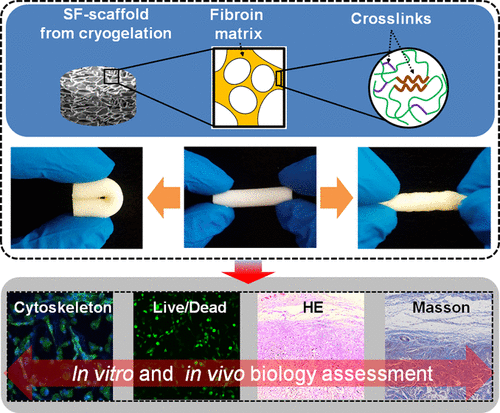当前位置:
X-MOL 学术
›
ACS Biomater. Sci. Eng.
›
论文详情
Our official English website, www.x-mol.net, welcomes your
feedback! (Note: you will need to create a separate account there.)
Controlled Cryogelation and Catalytic Cross-Linking Yields Highly Elastic and Robust Silk Fibroin Scaffolds
ACS Biomaterials Science & Engineering ( IF 5.4 ) Pub Date : 2020-06-25 , DOI: 10.1021/acsbiomaterials.0c00752 Zhinan Mao 1 , Xuewei Bi 2, 3 , Fan Ye 1 , Xiong Shu 4 , Lei Sun 4 , Juan Guan 1, 3 , Robert O. Ritchie 5 , Sujun Wu 1
ACS Biomaterials Science & Engineering ( IF 5.4 ) Pub Date : 2020-06-25 , DOI: 10.1021/acsbiomaterials.0c00752 Zhinan Mao 1 , Xuewei Bi 2, 3 , Fan Ye 1 , Xiong Shu 4 , Lei Sun 4 , Juan Guan 1, 3 , Robert O. Ritchie 5 , Sujun Wu 1
Affiliation

|
Silk biomaterials with tunable mechanical properties and biological properties are of special importance for tissue engineering. Here, we fabricated silk fibroin (SF, from Bombyx mori silk) scaffolds from cryogelation under controlled temperature and catalytic cross-linking conditions. Structurally, the cryogelled scaffolds demonstrated a greater β-sheet content but significantly smaller β-sheet domains compared to that without chemical cross-linking and catalyst. Mechanically, the cryogelled scaffolds were softer and highly elastic under tension and compression. The 120% tensile elongation and >85% recoverable compressive strain were among the best properties reported for SF scaffolds. Cyclic compression tests proved the robustness of such scaffolds to resist fatigue. The mechanical properties, as well as the degradation rate of the scaffolds, can be fine-tuned by varying the concentrations of the catalyst and the cross-linker. For biological responses, in vitro rat bone mesenchymal stem cell (rBMSC) culture studies demonstrated that cryogelled SF scaffolds supported better cell attachment and proliferation than the routine freeze-thawed scaffolds. The in vivo subcutaneous implantation results showed excellent histocompatibility and tissue ingrowth for the cryogelled SF scaffolds. This straightforward approach of enhanced elasticity of SF scaffolds and fine-tunability in mechanical performances, suggests a promising strategy to develop novel SF biomaterials for soft tissue engineering and regenerative medicine.
中文翻译:

受控的低温凝胶化和催化交联可产生高度弹性和坚固的丝素蛋白支架。
具有可调节的机械特性和生物特性的丝绸生物材料对于组织工程特别重要。在这里,我们制造了丝素蛋白(SF,来自Bombyx mori丝)支架在受控温度和催化交联条件下冻干。在结构上,与没有化学交联和催化剂的情况相比,冷冻凝胶支架显示出更大的β-折叠含量,但β-折叠结构域明显更小。在机械上,冰冻的支架在拉伸和压缩下更柔软并且具有高弹性。120%的拉伸伸长率和> 85%的可恢复压缩应变是SF支架的最佳性能。循环压缩试验证明了这种支架抵抗疲劳的坚固性。可以通过改变催化剂和交联剂的浓度来微调支架的机械性能以及降解速率。对于生物反应,体外大鼠骨间充质干细胞(rBMSC)培养研究表明,与常规的冻融支架相比,冻融的SF支架支持更好的细胞附着和增殖。的体内皮下植入的结果显示出对SF cryogelled支架优异的组织相容性和组织向内生长。这种提高SF支架弹性和机械性能的微调的直接方法,为开发用于软组织工程和再生医学的新型SF生物材料提出了有希望的策略。
更新日期:2020-08-10
中文翻译:

受控的低温凝胶化和催化交联可产生高度弹性和坚固的丝素蛋白支架。
具有可调节的机械特性和生物特性的丝绸生物材料对于组织工程特别重要。在这里,我们制造了丝素蛋白(SF,来自Bombyx mori丝)支架在受控温度和催化交联条件下冻干。在结构上,与没有化学交联和催化剂的情况相比,冷冻凝胶支架显示出更大的β-折叠含量,但β-折叠结构域明显更小。在机械上,冰冻的支架在拉伸和压缩下更柔软并且具有高弹性。120%的拉伸伸长率和> 85%的可恢复压缩应变是SF支架的最佳性能。循环压缩试验证明了这种支架抵抗疲劳的坚固性。可以通过改变催化剂和交联剂的浓度来微调支架的机械性能以及降解速率。对于生物反应,体外大鼠骨间充质干细胞(rBMSC)培养研究表明,与常规的冻融支架相比,冻融的SF支架支持更好的细胞附着和增殖。的体内皮下植入的结果显示出对SF cryogelled支架优异的组织相容性和组织向内生长。这种提高SF支架弹性和机械性能的微调的直接方法,为开发用于软组织工程和再生医学的新型SF生物材料提出了有希望的策略。











































 京公网安备 11010802027423号
京公网安备 11010802027423号